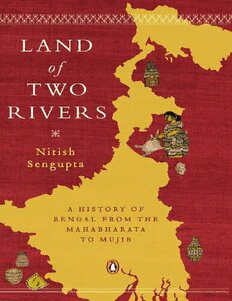
Land of Two Rivers: A History of Bengal from the Mahabharata to Mujib PDF
Preview Land of Two Rivers: A History of Bengal from the Mahabharata to Mujib
NITISH SENGUPTA Land of Two Rivers A History of Bengal from the Mahabharata to Mujib PENGUIN BOOKS Contents About the Author Dedication Preface Maps ANCIENT BENGAL 1. Bengal or Bangla: Land of Two Rivers 2. Prehistoric and Ancient Bengal 3. First Gaur Kingdom under Sasanka 4. The Imperial Palas 5. The Sen Dynasty EARLY MEDIEVAL BENGAL 6. Turkish Invasion: The Kingdom of Gaur under Early Turkish Rulers 7. Ilyas Shahi Dynasty 8. The Short-lived Dynasty of Raja Ganesh and Other Rulers 9. Islam Spreads in Bengal EMERGENCE OF BENGAL IN HISTORY 10. The Golden Age of Hussain Shah 11. Origin and Growth of Bengali 12. Shri Chaitanya and Bengali Vaishnavism LATE MEDIEVAL PERIOD 13. The Pathans and Mughals Fight over Bengal 14. Bengal Becomes a Province of the Mughal Empire 15. Appearance of Europeans 16. Era of Independent Nawabs of Bengal 17. The Battle of Plassey 18. End of Independent Nawabs of Bengal 19. Era of Warren Hastings MODERN BENGAL 20. Agrarian, Industrial and Economic Changes 21. Anti-Government Popular Disturbances 22. Bengal Renaissance 23. Hindu Religious Reform Movements 24. Beginnings of Political Awareness: Towards a Nation in the Making 25. Growth of Muslim Separatism 26. First Partition of Bengal 27. Armed Revolutionary Movement or Agni Yug: First Phase 28. Over a Decade of Hindu–Muslim Camaraderie 29. Agni Yug, Second Phase 30. Unmaking of a Nation 31. Parting of Ways 32. Rise and Fall of Netaji Subhas Bose 33. The Last Hour of United Bengal 34. Second Partition of Bengal EAST BENGAL UNDER PAKISTAN 35. The Decimation of the Muslim League 36. The Power Struggle between East Bengal and West Pakistan 37. Crystallization of the Bangladesh Concept 38. Pakistan’s Second Martial Law 39. Bangladesh’s War of Independence WEST BENGAL 40. The West Bengal Story Epilogue Illustrations Annexure A: Excerpt of J.N. Mandal’s Resignation Letter Annexure B: The Awami League’s Six-point Programme, 1966 Annexure C: Bangabandhu Sheikh Mujib’s 7 March 1971 Address Annexure D: Instrument of Surrender Select Bibliography Endnotes Copyright Page PENGUIN BOOKS LAND OF TWO RIVERS Academician, administrator, politician and author, Nitish Sengupta studied at Presidency College, Kolkata, winning a gold medal for his master’s in history. He began his career as assistant professor of history and joined the Indian Administrative Service (IAS) in 1957. He held key posts in the Union government including revenue secretary and member-secretary, Planning Commission. After completing his doctorate in management from Delhi University, he lectured at several universities and leading management schools in the country. After his retirement, he was director- general of the International Management Institute, New Delhi. Nitish Sengupta has represented India at various UN bodies and was elected chairman of the UN Commission on Transnational Corporations. He joined politics in 1996 and was elected to the Thirteenth Lok Sabha, where he served as member of several key committees, notably the Public Accounts Committee. He was also general secretary, All India Trinamool Congress. Currently, he holds the position of chairman, Board for Reconstruction of Public Sector Enterprises, New Delhi. He has been a regular columnist in leading dailies and is the author of twelve books, including several related to management. As a historian, his well-known works are History of the Bengali-speaking People, Dr B.C. Roy, Biography and Bengal Divided. He has also authored Unshackling of Indian Industry, Government and Business, Inside the Steel Frame and My Times—A Civil Servant Remembers. Dedicated to the fond memory of Sunanda, my life partner who is no more
